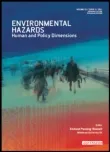- | Academic & Student Programs Academic & Student Programs
- | Journal Articles Journal Articles
- |
What drives television weather coverage?
Originally published in Environmental Hazards
Weather forecasts meet the classic economic definition of a public good, since the content can be easily relayed to non-payers and the cost of sharing the forecast with an additional person is zero. Freeriding by consumers leads to the potential for an inefficiently small supply of public goods by the market.

Weather forecasts meet the classic economic definition of a public good, since the content can be easily relayed to non-payers and the cost of sharing the forecast with an additional person is zero. Freeriding by consumers leads to the potential for an inefficiently small supply of public goods by the market. Yet television networks and stations provide a large quantity of weather coverage. This paper explores the investment by US television stations in weather coverage. Specifically, we examine whether greater investments are made in cities where weather is potentially more dangerous. We find strong evidence that tornado risk drives coverage and weaker evidence for floods and hurricanes, but discover that snowfall is unrelated to investment. In addition, stations in larger markets invest more in weather coverage, and we also find regional patterns in coverage.
Find the article at Taylor & Francis.
To speak with a scholar or learn more on this topic, visit our contact page.

